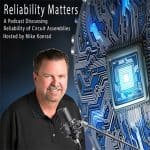
Storage of Test Parts
Abstract
Dianna and Fred discussing the effects of handling, cumulative test, and storage of test parts on test results.
ᐅ Play Episode
Your Reliability Engineering Professional Development Site
by Dianna Deeney Leave a Comment

Dianna and Fred discussing the effects of handling, cumulative test, and storage of test parts on test results.
ᐅ Play Episode
by Dianna Deeney Leave a Comment


What is engineering in the color economy?
We explore facets of sustainable economic models: Green, Blue, Yellow, and Orange.
Where do you fit in now? Where would you like to be? And how can you make design choices within each (or all!) of these color economies?
by Christopher Jackson Leave a Comment

Redundancy has continually proven not always to be redundant. Whether the Fukushima nuclear power plant or United Airlines Flight 232, additional components or subsystems that are supposed to take over when others have failed don’t always work. Why is that? There are quite a few reasons … many of which we already know about. But time and time again, otherwise, smart people choose to ignore what we know about how to REALLY make things redundant in order to save costs, save thinking, or otherwise confuse efforts with outcomes. In this webinar, we will look at how redundancy is described in textbooks … and how it can go wrong in the real world.
[Read more…]
by Mike Konrad Leave a Comment

Welcome back to another episode of the reliability matters podcast. For those who are counting, this is episode number 108. SMTA is well known for producing high-quality relevant technical conferences and symposiums. This includes, among others, the technical conference held at SMTAI, the High reliability cleaning and coating conference, the symposium on counterfeit parts and materials, the Advanced Electronics Assembly Conference, the Wafer-Level Packaging Symposium, the Electronics in harshenvironments conference, and, perhaps my favorite, the Pan Pacific microelectronics symposium, often referred to as PanPac.
PanPac is unique in many ways beginning with its venue. PanPac is held annually at one of the Hawaiian islands. This fact alone makes this symposium stand out. But there are many other factors that make this symposium unique. Let me quote from PanPac’s steering committee:
The Pan Pacific Microelectronics Symposium strives to build bridges and nurture relationships across all boundaries; oceans and cultures, industries and technologies, companies and individuals. Its location in Hawaii always provides the requisite isolation from day to day distractions necessary to support these goals and enhance personal face to face interactions. The Pan Pacific continues its mission of building the vision and future directions for the electronics industry!
PanPac 2023 is scheduled for January 30 – February 2, 2023
At the Sheraton Kauai Resort on the beautiful island of Kauai.
While I love attending technical conferences and symposiums just for the educational opportunity, PanPac there’s just something special about this conference. While all conferences provide an element of networking, I have forged many new relationships, friendships, and collaborative agreements with fellow attendees and speakers. Perhaps it has something to do with being on a tropical island for a few days with like-minded people. To talk more about the upcoming Pan Pacific microelectronics symposium, I invited to colleagues who are instrumental in curating the technical contact for this symposium. Dr. Chuck Bauer, one of the original creators of this symposium and Keith Bryant join me to discuss the conferences technical tracks and
presentations as well as their view on what makes this conference unique.
More Information:
https://smta.org/mpage/panpac/
by Dianna Deeney Leave a Comment

Dianna and Fred discussing the history and application of published parts count prediction models and standards in reliability analysis.
ᐅ Play Episode
by Dianna Deeney Leave a Comment

What makes a great design?
It depends.
We talk about the spectrum of designs (from great to spam), the various customers engineers need to design for, and how engineers can work with their team toward defining what a great design should be.
by Carl S. Carlson Leave a Comment

Carl and Fred discussing what brings enjoyment to one’s life and work, and how to explore and learn, with curiosity.
ᐅ Play Episode
by Christopher Jackson Leave a Comment

Chris and Fred discuss how we communicate reliability to our customers. And they haven’t completed university courses in reliability engineering …
ᐅ Play Episode
by Dianna Deeney Leave a Comment

We worked on a project with our team and met our goal!
Except, management isn’t happy – they expected something else.
Seeing if we have alignment on goals is easy if we gather the team and stakeholders for 10 minutes and use a continuum.
There are certain categories that goals will fall within. A continuum is a way we can list those categories, get alignment, and gain an understanding of how ‘big’ of a project this is going to be. We get clarity on our goals.
Is it hard? Not at all. Is it eye-opening? Sometimes. It can help us move forward with a discussion to help ensure we’re all successful.
by Fred Schenkelberg Leave a Comment

The reliability performance of a product or system exists because the decisions that occur during the creation of the product establish how well an item will survive without failure. The choice of material, finish, or technologies, along with all the other decisions involved, define how well a product performs, including its reliability. [Read more…]
by Mike Konrad Leave a Comment

Like most manufacturers, the electronic manufacturing industry relies on countless suppliers to fulfill its manufacturing needs. I’m quite certain there is no one within the EMS space who fabricates their own boards using materials produced in house, operates their own semiconductor foundries, designs and manufacturers their own components, and produces soldering materials for their reflow process. Our industry relies on a vast network of manufacturers throughout the world to build even the simplest electronic assembly.
Intellectual property security, cyber security, national security, are all hot topics today. No one wants their hard-earned intellectual property stolen. This is most true within The US military establishment. There are, at present, numerous policies, procedures, and regulations designed to protect various parts of our supply chain from unscrupulous people and companies.
Today, companies are concerned about “controlled unclassified information” (CUI) and “controlled technical information” (CTI). That brings us to IPC-1791. What is IPC-1791? My guest today, IPC’s Randy Cherry will explain.
Randy is Director of Validation Services at IPC. Validation Services is a series of certification programs that qualify products and processes to the IPC industry standards.
Once companies have completed their certification they are listed as an IPC Trusted Supplier on the IPC Validation Services website.
Randy has over 30 years experience in Engineering with Printed Circuit Board and Backplane fabs, High-Speed Pressfit Backplane Connectors, and SMT (Surface Mount Technology) Assembly practices. He is a certified SMT Process Engineer and an IPC Auditor, and, he’s my guest today on this episode.
Randy’s Contact Info:
Randy Cherry | Director, Validation Services
IPC
3000 Lakeside Drive, Suite 105 N,
Bannockburn, IL 60015
Office: +1 847-597-2806
Mobile: +1 630-470-4721
randycherry@ipc.org
www.ipc.org
www.ipc.org/validation
by Christopher Jackson Leave a Comment

Chris and Fred discuss the difference between ‘confidence,’ ‘tolerance’ and ‘prediction’ intervals. Is there any point in understanding the difference between these concepts? … or is it something only statisticians find useful?
ᐅ Play Episode

Kirk and Fred discussing Multiple Environmental Over Stress Test or MEOST.
ᐅ Play Episode
by Dianna Deeney Leave a Comment

Relationships matter! And they can be difficult to understand.
We’re taking relationships between variables. Does one variable affect another? Or do they just correlate? Understanding which matters to the values of our decisions.
We talk about the saying “Correlation does not imply causation”, how to find a confounding variable, and ways to check that we’ve got the triggering cause that’s going to affect our outcome.